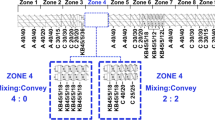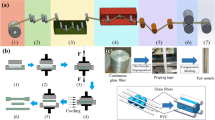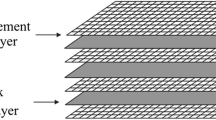Abstract
Reducing cycle time in injection molding process is important because it can save operational cost and increase product yield. Cycle time can be categorized by six criteria, which are metering time, time for closing a mold, packing time, holding time, cooling time, and the time needed to open a mold and to eject the molded product. It was found that the metering time is crucial to predict the cycle time of glass fiber reinforced syndiotactic polystyrene (sPS/GF, 60/40 by weight). In many cases, however, cycle time could be reduced by saving cooling time. This study is motivated by the demand to reduce the cycle time of sPS/GF composite. Since the increase of thermal conductivity leads to the reduction of cooling time, silicon carbide (SiC) is employed to evaluate if it can increase the thermal conductivity of sPS/GF composite. When SiC is added to replace entire GF in sPS/GF composite, the mechanical property of the resulting sPS/SiC (60/40 by weight) composite was not satisfied even though its thermal conductivity was enhanced to about 62 %. Within tolerable ranges in mechanical properties, SiC was added to replace a half amount of existing GF filler. sPS/GF/SiC (60/20/20 by weight) composite achieved the enhancement of thermal conductivity from 0.230 to 0.308 W/m K (34 %) which resulted in the effective reduction of both cooling time and cycle time from 16 to 10 s and from 47 to 38 s, respectively. It should be noted that additional time saving was obtained by 3 s between 6 s in cooling and 9 s in overall cycle time. It can be interpreted by the fact that the increase of thermal conductivity also accelerated the heating rate of sPS/GF/SiC composite.






Similar content being viewed by others
References
Rosato DV, Rosato MG (2003) Injection molding handbook, 3rd edn. Kluwer Academic Publishers, Boston 1
Hwang DK, Lee HS, Oh K (2014) Method development to evaluate melting behavior of glass fiber-reinforced syndiotactic polystyrene composites in the presence of pressure loading. Polym Plast Technol Eng 53:1028–1034. doi:10.1080/03602559.2014.886060
Bicerano J (2009) Prediction of polymer properties, 3rd edn. Marcel Dekker, New York
Ebadi-Dehaghani H, Nazempour M (2012) Thermal conductivity of nanoparticles filled polymers. In: Hashim A (ed) Smart nanoparticles technology, vol 23, pp 519–540
Zamani MM, Fereidoon A, Sabet A (2012) Multi-walled carbon nanotube-filled polypropylene nanocomposites: high velocity impact response and mechanical properties. Iran Polym J 21:887–894
Liu K, Lu S, Li S, Huang B, Wei C (2012) Mechanical and thermal properties of POSS-g-GO reinforced epoxy composites. Iran Polym J 21:497–503
Alaei MH, Mahajan P, Brieu M, Kondo D, Rizvi SJA, Kumar S, Bhatnagar N (2013) Effect of particle size on thermomechanical properties of particulate polymer composite. Iran Polym J 22:853–863
Sorrentino A, Pantani R, Brucato V (2006) Injection molding of syndiotactic polystyrene/clay nanocomposites. Polym Eng Sci 46:1768–1777
Kadam P, Kute R, Mhaske S (2013) Effect of nano-alumina concentration on the properties of poly(vinyl chloride)/thermoplastic polyester elastomer blend system. Iran Polym J 22:549–560
Guerra G, De Rosa C, Vitagliano VM, Petraccone V, Corradini P (1991) Effects of blending on the polymorphic behavior of melt-crystallized syndiotactic polystyrene. J Polym Sci Polym Phys 29:265–271
Ma A, Li H, Chen W, Hou Y (2013) Improved thermal conductivity of silicon carbide/carbon fiber/epoxy resin composites. Polym Plast Technol Eng 52:295–299
Parker WJ, Jenkins RJ, Butler CP, Abbott GL (1961) Flash method to determining thermal diffusivity, heat capacity, and thermal conductivity. J Appl Phys 32:1679–1684
http://webserver.dmt.upm.es/~isidoro/bk3/c11/Heat%20conduction.pdf. Accessed 14th June 2014
Kazmer DO (2007) Injection mold design engineering. Carl Hanser Verlag, Munich 9
Rao NS, Schumacher G, Schott NR, O’Brien KT (2002) Optimization of cooling systems in injection molds by an easy applicable analytical model. J Reinf Plast Compos 21:451–459
Rao NS, Schumacher G (2004) Design formulas for plastics engineers, 2nd edn. Hanser Publishers, Munich
Vosteen H-D, Schellschmidt R (2003) Influence of temperature on thermal conductivity, thermal capacity and thermal diffusivity for different types of rock. Phys Chem Earth 28:499–509
Author information
Authors and Affiliations
Corresponding author
Rights and permissions
About this article
Cite this article
Hwang, D.K., Oh, K. Reduction of cycle time by addition of silicon carbide filler to syndiotactic polystyrene/glass fiber composites. Iran Polym J 23, 717–722 (2014). https://doi.org/10.1007/s13726-014-0266-3
Received:
Accepted:
Published:
Issue Date:
DOI: https://doi.org/10.1007/s13726-014-0266-3




